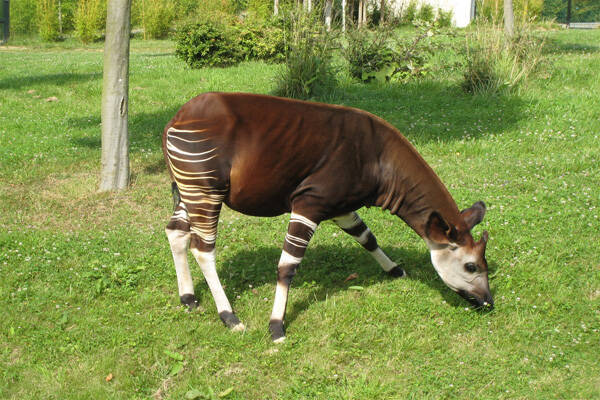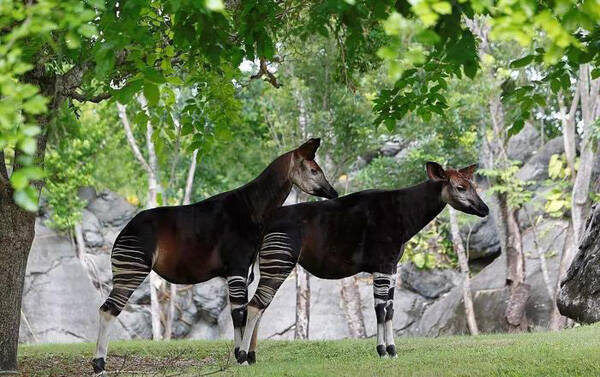Okapia johnstoni
IUCN
LCBasic Information
Scientific classification
- name:Okapia johnstoni
- Scientific Name:Okapia johnstoni,Okapi
- Outline:Ungulata
- Family:Artiodactyla Giraffidae Okapi
Vital signs
- length:1.9-2.5m
- Weight:180-317kg
- lifetime:20-33years
Feature
The hips and upper legs have horizontal black and white stripes
Distribution and Habitat
The okapi is endemic to Africa and is restricted to the forests of the Democratic Republic of Congo, with distribution in parts of the central, northern, and eastern parts of the country. North and east of the Congo River, the okapi is found from the Maiko forest north to the Ituri forest, west across the Rubi, Tele, and Ebola river basins, and north to the Ubangi River.
The okapi is found in dense tropical rainforests in eastern and northern Democratic Republic of Congo, such as in nature reserves such as Virunga National Park. The okapi lives at altitudes of 500-1000 meters in the eastern montane rainforests and alpine forests, but occasionally rises above 1000 meters. In the western swamp forests, the savannah in the north, and the open woodlands in the south, the range is limited to below 500 meters.
Appearance
Adult okapis weigh 180-317 kg, are between 1.9-2.5 meters long, have a tail length of 30 to 42 cm, and are about 1.5-1.65 meters tall at the shoulder. Females are larger than males on average.
The fur of the okapi is short, slightly greasy to the touch, has a delicate scent, and is chocolate-colored with a velvety sheen of red and crimson. The forehead, neck and body are brown, with camel or gray cheeks, throat and chest. There are horizontal black and white stripes on the buttocks and upper legs. Some people think that these stripes are used as a "follow me" sign in the dense rainforest, allowing young animals to keep up with their mothers, and they can also serve as camouflage. The lower legs are white or light brown. The face is black and white. The neck and legs are obviously extended, but not to the extent of a giraffe. Males have two short, antlered horns, and females are hornless. The tongue of the okapi is blue, very long, about 30 cm, and very flexible. Okapis use
Details
Okapi (scientific name: Okapia johnstoni) is called Okapi in English. At first glance, it looks more like a horse. Because of the alternating black and white stripes on its back, it looks very much like a zebra. In the past, some people thought that the okapi was the result of the mating of a giraffe and a zebra, but in fact, it is not a close relative of the zebra. The giraffe looked similar to the okapi before its neck became longer. The Latin name of the okapi is Okapia johnstoni. The genus name Okapia is taken from the local name for it, o'api. Its species name johnstoni is to commemorate Harry Johnston, who first obtained the skull of the okapi.

The Okapi is primarily a diurnal animal, but has also been observed feeding at night. The Okapi is a herbivore, feeding on leaves, shoots, grasses, ferns, fruits, and fungi. They prefer to forage in the crevices of trees and have a wide range of diets, feeding on more than 100 plant species. It feeds mainly on mature leaves of understory trees, shrubs, and vines, often consuming woody dicots and rarely monocots. The scattered tasty leaves of the understory are rare, and most of them are composed of leaves protected by chemicals, some of which are toxic to humans or other animals. Okapis often move between different plant species when feeding, and even feed selectively within a single plant, probing with their snout and lips, then rolling up and eating small branches and leaves with their tongue. Captive okapis eat 3.6 to 5.6 kg of dry food per day.
Okapis are highly solitary animals, only gathering when breeding, and they spend most of their time standing still, hiding in the understory of the forest. In the Edoro study area of the Okapi Wildlife Reserve in the Democratic Republic of Congo, adult males have annual home ranges of 10 to 17 square kilometers, overlapping with other males. Adult females, in contrast, have exclusive home ranges of 4 to 7 square kilometers.
Male okapis move erratically, sometimes staying in a relatively small area for a week or more, then suddenly moving a long distance to another area. Female okapis move steadily within their home ranges, occasionally leaving. Breeding females have their favorite understory vegetation in their home ranges, which they consume extensively when nursing or with cubs. Okapis mark their ranges by rubbing their necks on tree trunks, sometimes leaving with a brown discharge. Male okapis mark their ranges by urinating on low understory brush or leaves. Sometimes okapis also use stamping, usually on their front feet, to secrete foot glands to mark.

Okapi fighting has not been directly observed, but one male was observed with a wound on his side, possibly from the horns of another male. On another occasion, two males were found dead in the same open pit, and judging from the trampled vegetation at the scene, they had hit each other and pushed each other into the pit.
Leopards are the main predator of okapis, and other potential predators include venomous snakes. In the Edora study area of the Okapi Wildlife Reserve in the Democratic Republic of the Congo, a five-year study showed that nearly 18% of radio-collared okapis were killed by leopards, mainly young and adult male okapis. One young okapi was killed by a snake bite.
April to July is the estrus season for okapis. At this time, male okapis wander in their territory, looking for females in the same estrus period. Males judge whether the other party is in estrus by the smell of female urine. After determining the target, the male will slowly approach the female, get familiar with each other's smell, and then gradually approach and get familiar with each other, and finally mate. After mating, the male will leave immediately, and the gestation period is 421 to 457 days. Generally, the baby is born between August and October, and the baby weighs 14-30 kg at birth. The lactation period is about 10 months, and the okapi's reproductive cycle interval is about 14-15 months. The expectant mother will retreat into the dense forest before reproduction, and the mother and child will hide in the dense forest for several days after the birth of the newborn. It will not appear until a few days later, and then the mother will not be far away from the child. The young okapi always stays near the mother and follows the mother's activities at all times. Okapis only give birth to one litter at a time, and the gestation period and lactation period are very long, so the reproduction rate is very low.

A newborn okapi can stand up after 20 minutes, can feed itself within an hour, can double its weight within a month, and after two months, its weight is already three times that of its birth. The okapi's lactation period lasts up to 6 months. Interestingly, in the first two months, the okapi does not defecate at all. This is a way for them to protect themselves - this prevents the smell of feces from attracting natural enemies. After 6 months of nursing, the young okapi can leave its mother and start living independently. It takes about 3-5 years for the okapi cub to reach sexual maturity and start a new round of reproduction. The mother okapi uses infrasound communication to communicate with the young okapi. This is sound, which is below the human hearing range. Elephants also have this physiological phenomenon. The life span of okapis can generally reach 20 years, and the recorded life span of "longevity stars" has reached 33 years. The life span of captive okapis is more than 15-30 years.
The International Cryptozoology Society (ICS) is an entity organization established in 2016, composed of researchers such as Paul LeBlond and Loren Coleman. The name of the society inherits the name of the defunct cryptozoology organization ISC, and the official logo is okapi. In addition, in the original radio series of The Hitchhiker's Guide to the Galaxy, the protagonist Arthur Dent's brother was said to be killed by an okapi. The radio series did not elaborate on what happened.

Okapi can coexist with humans in forests with less human disturbance, but they will disappear in severely disturbed areas. The main threats are habitat loss, hunting, and the presence of illegal military organizations in and around major protected areas.
Researchers point out that there are about 4,000 to 6,000 of these precious animals in the Democratic Republic of Congo's national reserve. The overall number of okapis is on a downward trend. In 1999, East, an antelope expert and member of the International Union for Conservation of Nature's Antelope Specialist Group, estimated that the number of okapis may exceed 10,000, and in 2013, the number of okapis was estimated to be 35,000 to 50,000. Because okapis are very timid and live in the dense forests of a country in the midst of civil war, little is known about their wild habits, and there are only guesses about their wild numbers. A rough guess (but very unreliable) is that there are 10,000 to 20,000 wild individuals. Although okapis are not listed as threatened animals, they are threatened by the destruction of their habitat and poaching. Zoologists are still working to study the wild behavior of okapis in the Democratic Republic of Congo.
The Okapi Wildlife Sanctuary was established in 1992. The civil war in the Democratic Republic of Congo threatens both the okapi and the lives of the people who work in the sanctuary. In March 2013, the International Union for Conservation of Nature (IUCN) established a new Giraffe and Okapi Specialist Group, co-chaired by the Zoological Society of London (ZSL), to coordinate research and conservation of giraffidae species and support the implementation of an okapi conservation strategy. In May 2013, at a workshop in the Democratic Republic of Congo, ZSL, in collaboration with the Congolese Institute for the Conservation of Nature (ICCN), developed the first Okapi Conservation Strategy.
Listed in the 2012 Red List of Threatened Species of the World Conservation Union (IUCN) ver 3.1 - Endangered (EN).
Protect wild animals and eliminate game.
Maintaining ecological balance is everyone's responsibility!








